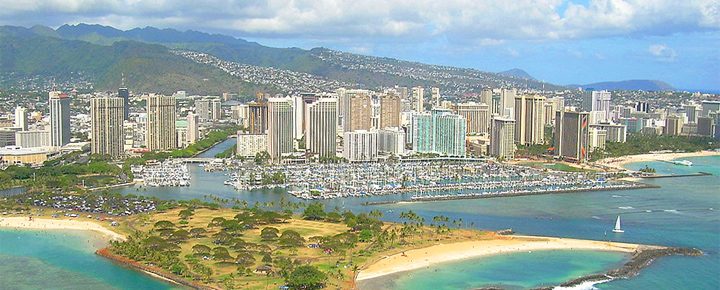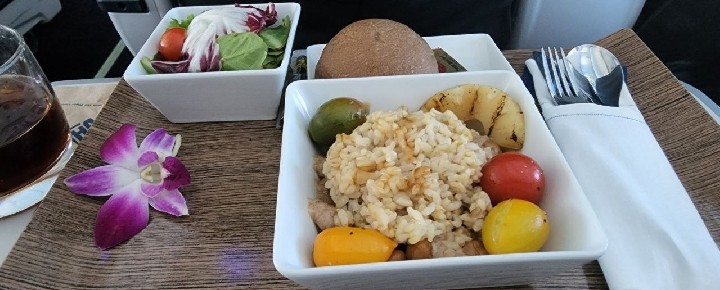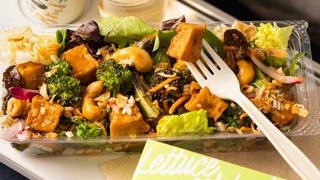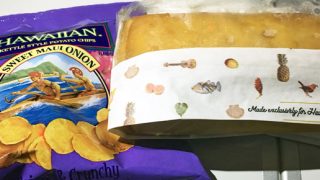Airline food went the same way as the cheap ticket. If you find it for free on Hawaiian Airlines and for a fee on others, and can palate the taste, you’ll be eating food high in fat, salt, and sugar. Airline food is generally hard to digest due to the effect of low air pressure on your gut. Studies show that people feel better when they eat the opposite, with somewhat more carbohydrates and less fat. In general many studies shows that airline food has a long way to go.
Don’t get stuck. Just think on-board picnic!
Flights to Hawaii are long and you are going to get hungry. And that’s assuming there are no unexpected delays en route.
To have fun, tasty and nutritious food on board, and be the envy of your fellow passengers and flight crew alike (we say this from experience), you need to bring your own. With advance planning, you can easily eat like a King or Queen on the plane. Another advantage is that food is served on your schedule and not on the crew’s.
On your way home from Hawaii, be sure to keep agriculture inspection in mind. Whole fruits and vegetables are a definite no no. On the other hand, when it comes to cut up fruits and salads in containers, out of hundreds of trips, we’ve never had a problem and have only been asked about them one time.
Five Time Saving Tips for Foodie Travel.
1. Choose your foods: Salads, casseroles and sandwiches work great for entrees.
One option is to freeze your favorite leftovers during the days leading up to your Hawaii vacation. Most any food that tastes good cold will do, and in this way there is virtually no extra work in preparing your custom airline meals.
2. Plan snacks for on-board treats.
Remember the days of cashews served by the airline? Just cater your own favorite snacks. We like energy bars, trail mix, nuts, and seed crackers among other things.
3. Pick your food containers: Use inexpensive recyclable plastic or reusable silicone.
You can try using just plastic wrap and aluminum foil. But in our experience, food tends to get crushed in the rush of travel. Therefore we choose more sturdy choices for all but snacks. Once the food is in containers, you can keep it in the freezer until defrosting prior to departure. These containers work great for lunches while on your vacation as well as for the return trip. In the past we used disposable Glad food storage containers. Now we’ve switched to the great new collapsible silicone containers, which we love. Replete with collapsible water bottles to match. These are some of our permanent travel paraphernalia additions.
4. Get ready the night before to avoid last minute stress.
Make sandwiches and move the casseroles from freezer to refrigerator to thaw. If the casserole you’re bringing is quite perishable (which we don’t recommend), only partially thaw it before packing. It can then safely finish thawing as you travel and help keep everything cool at the same time.
Each container (plus plastic cutlery and paper towels) goes in a plastic gallon bag to avoid leaks in carry-on luggage. Salad dressing goes into a small container which can be put inside the one quart TSA “liquids” bag. Then all the food and snacks go into a reusable zippered insulated bag that then stuff into your carry-on. Those bags are a must for Hawaii vacations.
5. Grab and go.
When not starting from home, or if something goes awry, you can always stop at a grocery store the night before or en route to the airport and hit the salad and deli bars. But from that point, package it just the same as if you made it.
Do you have any favorite airline food tips? Be sure to post them here.
Get Breaking Hawaii Travel News







TSA made my wife throw away containerized sandwiches and fresh cherries flying from Philadelphia to LAX. We are heading to Kauai in 10 days. Do you think LAX to Lihue TSA agents are more enlightened?
I’ve not had a problem getting through TSA with LunchBlox (Rubbermaid) which have divisions like bento boxes–for variety within the meal. It comes with a small flat blue ice that sandwiches in place between the containers. And it’s handy for carrying leftovers or snacks from Honolulu to the North Shore during our stay. I also found your tip of freezing grapes helps keep other foods cold too. In air, I like to take a salad made with redskin potatoes, whatever veggies I have on hand like green beans or zucchini and mushrooms, greens or whatever– and dress it with 3-2-1 “parts” dressing: balsamic, dijon, maple syrup. No fat, tasty and filling.
Our standard in-fight meal from Oahu to the Mainland is a bahn mi (Vietnamese sandwich) from Saigon Noodle House or Bah Le plus a spring roll/shrimp roll and some tapioca. Just once we had an argument over the tapioca, until a more knowledgeable TSA agent intervened on our behalf. Sushi also works well. Your food packing recommendations are spot on. We also carry nuts and dried fruit for in-flight snacks headed in both directions.